|
|
Arrangements & Transcriptions of Bach's Works
Works using the Name Bach (The BACH Motif) |
|
Introduction |
|
In German usage the note B flat is called B, and B natural is called H. This allows Bach's name to be expressed as a musical motif, B flat-A-C-B natural (see: Ex. 1), and the composer himself used it in one of the fugue subjects of the final (unfinished) contrapunctus in his Art of Fugue BWV 1080 (see: Ex. 2). Its presence has been observed elsewhere in Bach's works, for example in the first movement of the Second Brandenburg Concerto BWV 1047 (bars 109-12, bass) and towards the end of the Canonic Variations for organ BWV 769; but such instances are not beyond the realm of coincidence, and the four notes are very likely to be found close together when the music veers towards the subdominant in the closing bars of a piece in C major. Bach would certainly have been well aware of the
motif's possibilities before he came to write the Art of Fugue, however-Johann Gottfried Walther referred to it in his Musicalisches Lexicon (1732) - but the attribution to him of a Prelude and Fugue in B flat major on the name BACH, BWV 898, is generally considered to be without foundation. The motif appears also on the Bach Goblet.
Several fugues on the BACH motif were penned by J.S. Bach's sons and pupils, and the Bach revival of the 19th century brought a surge of interest in its possibilities for Romantic expression. Robert Schumann, Franz Liszt, Max Reger, and Ferruccio Busoni all based notable works on it, and the Second Viennese School of Arnold Schoenberg and his disciples found it easy to incorporate into totally chromatic, serial works. Not surprisingly, perhaps, a large proportion of the works based on the motif are for organ, and in many cases they take the form of tributes on the occasions of important anniversaries (in 1950, 1985 and 2000, for example).
The list that follows, which has been compiled from various sources, is as comprehensive as possible. The list is arranged alphabetically by composer name, and dates, where shown, are of composition (if known) or publication.
Source: Malcolm Boyd (Editor): Oxford Composer Companion - J.S. Bach (Oxford University Press, 1999), p. 50 |
|
Ex. 1: The BACH motif |
|

|
|
Ex. 2: Art of Fugue BWV 1080:19 |
|

|
|
The BACH signature cross: Even though the original source cannot yet be found, it is definitely something J.S. Bach might have created (reading notes upside-down as in the Musical Offering). The attribution to J.S. Bach has not as yet been
validated. |
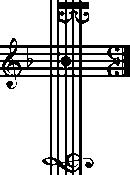 |
|
|
Contents |
|
Part 1: Bach Family
Part 2: Composers A-E
Part 3: Composers E-N
Part 4: Composers M-Z |
|
|
Part 1: Bach Family |
| |
Continue on Part 2 > |
|
Bach Family Bach | A | B | C | D | E | F | G | H | I | J | K | L | M | N | O | P | Q | R | S | T | U | V | W | X | Y | Z |
|
Bach: |
|
Concerto à 5 B-Dur (mit Schlußfuge B-A-C-H) [Kast, Bach-Incerta 35. Berlin (West), SPK St 144] |
|
Carl Philipp Emanuel Bach (1714-1788): |
|
Fuge on BACH in Clementi's "Practical Harmony for the Organ or Piano Forte containing Voluntaries, Fugues, Canons and other Ingenious Pieces, By the Most Eminent Composers to which is Prefixed an Epitome of Counterpoint by the. Editor," Vol. III. [London: W.C. Bates (1811-1815?)] [Leipzig: C. F. Peters, n.d.] | Works |
|
Carl Philipp Emanuel Bach (or Georg Andreas Sorge): Fuge über BACH, BWV Anh. 108, for keyboard instrument. In: Traugott Fedtke, B-A-C-H, Fugen der Familie Bach [Frankfurt: Peters (Litolff) Ed. Nr. 8526, 1984]. See score under G.A. Sorge entry | Works (Same work as above?) |
|
Symphony in C major H659, Wq 182, for string orchestra [Hamburg 1773, Zweiter Satz] [Frankfurt: Peters Ed. Nr. 8273 (hrsg. Traugott Fedtke)] (1773) | Works |
|
Musikalische Widmung an Johann Friedrich Reichardt. “Hamburg, den 12ten Julius 1774." [Druck: Johann Friedrich Reichardt, Briefe eines aufmerksamen Reisenden, die Musik betreffend. 2. Theil, Frankfurt und Breslau 1776, S. 22] (1776) | Works |
|
Johann Andreas Bach (1713-1779): |
|
Capriccio über BACH, c-Moll. In: Abschrift der Möllerschen Handschrift [Musikbibliothek Leipzig III. 8.3] [As Fragment c-Moll in: “Möllersche Handschrift" (SPK, Mus. ms. 40644) Bl. 15] [Abdruck der Schlußtakte: BJ 1954, S. 75] |
|
Johann Christian Bach (1735-1782): |
|
Fuge für das Pianoforte oder die Orgel (Fugue, for piano or organ). Komponiert von Christian Bach über die Buchstaben seines Namens BACH [Leipzig: A. Kühnel Bureau de musique, 1810. C. F. Peters 1885] [Neuausgabe: Traugott Fedtke, B-A-C-H, Fugen der Familie Bach] [Frankfurt: Peters (Litolff) Ed. Nr. 8526, 1984] |
|
Johann Christoph Friedrich Bach (1732-1795): |
|
Stammbucheintragung: Fughetta über HCF BACH [Berlin: SPK Mus. ms. Bach P 291] [In: Traugott Fedtke, B-A-C-H, Fugen der Familie Bach] [Frankfurt, Peters (Litolff) Ed. Nr. 8526, 1984] |
|
Johann Michael Bach (13) (1745-1820) |
|
Early set of piano concertos: the finale of No. 6 is a fugue on B-A-C-H (2nd half 18th c.) | Works |
|
Johann Nicolaus Bach (1669-1753): |
|
Johann Gottfried Walther Musicalisches Lexicon oder Musicalische Bibliothec (Leipzig, 1732) pp. 63-64
[at the end of the article on Bach (Joh. Sebastian)]
....Die Bachische Familie soll aus Ungern herstammen, und alle, die diesen Nahmen geführet haben, sollen so viel man weiß, der Musik zugethan gewesen seyn, welches vielleicht daher kommt: daß so gar auch die Buchstaben b’ a’ c” h’ in ihrer Ordnung melodisch sind. (Diese Remarque hat den Leipziger Hrn. Bach zum Erfinder.)
[...The Bach family is said to come from Hungary, and all those with this (sur)name, have been been devoted to music as far as can be determined. This perhaps
is due to the fact that even the letters b a c h (the c is middle c and the other notes lie directly below it) are melodic in their sequence of letters. {This comment originated with Mr. Bach, ‘the Leipzig Bach’.}
Bach-Dokumente, ii, no. 323, footnote on p. 232:
It appears that an abbreviated version of Walther’s magnum opus appeared in Chemnitz, 1737 and 1749. In this short version, J. S. Bach’s biography is shortened.
Johann Gottfried Mittag, in his Hallischer Schulhistorie III. Theil (Halle, 1748) adds a footnote to the statement quoted above: “This comment originated with the famous royal court composer and cantor in Leipzig, Mr. Bach.”
In a personal copy of the original 1732 Musicalisches Lexicon, Walther corrected the following words “Ungern” to the correct spelling “Ungarn”;
“Jenaischen” to “Leipziger” . Accordingly, say the editors of the Bach-Dokumente, the ‘inventor’ of the ‘Remarque’ is probably Johann Nicolaus Bach and not J. S. Bach.
(Contributed by Thomas Braatz, August 7, 2011) |
|
J.S. Bach (1685-1750): |
|
Cantata BWV 23 Du wahrer Gott und Davids Sohn: Mvt. 1: Aria (Duet) (T. 22 f); Mvt. 3: Chorus [BGA V/1; NBA 1/8] (1723) | Recordings |
|
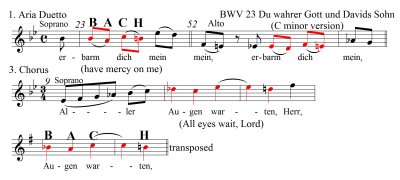
|
|
Kleines Harmonisches Labyrinth in C major, BWV 591, for organ
[BGA XXXVIII, S. 225f].
Not by J.S. Bach.
See entry under Johann David Heinichen |
|
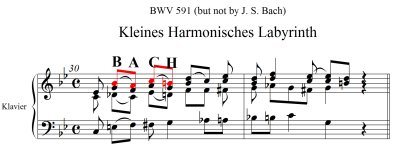
|
|
Chorale Prelude Gott, durch deine Güte, BWV 600, for organ [BG XXV/2, 3, 159; NBA IV/i, 3] (1713-1715) |
|
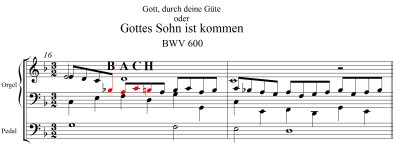
|
|
Chorale Prelude (Fantasia super) Komm, Heiliger Geist, BWV 651, for organ [BG XXV/2, 79; NBA IV/ii, 3, 117] (Before 1723) |
|
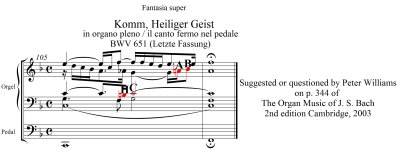
|
|
Chorale Prelude Komm, Gott Schöpfer, heiliger Geist (III), BWV 667, for organ (Before 1723)
Peter Williams states rather skeptically on p. 381 of his The Organ Music of J.S. Bach, 2nd Edition (Cambridge, 2003):
“Whether the altos in the final bar consciously enunciate B A C H is hard to know, but this second section does seem a response to the first, as if the Holy Ghost were accepting the invitation, and this were the end of the set.”
A closer inspection of the final measure of Variatio 5 of BWV 769 (The ‘Canonic Variations’) reveals the great similarities between the final measure of BWV 667 and that of Var. 5 of BWV 769. The movement from one alto part to another, in essence splitting the B-A from the C-H, seems to pose no special problem for Bach. The close proximity of the notes vertically and horizontally along with the B-A-C-H motif’s location in the final measure of the composition, enhances the probability that this is an intentional musical signature located at the conclusion of a significant work, one that had a special importance to Bach.
(Thomas Braatz, July 25, 2011) |
|
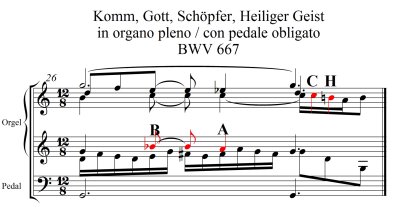
|
|
Chorale Prelude Vater unser im Himmelreich (II), BWV 682, for organ (1739)
From Peter Williams’ The Organ Music of J. S. Bach, 2nd edition, (Cambridge, 2003) pp. 415-416:
“Perhaps the most complex of all organ-chorales, for both composer and performer, this is a ritornello trio sonata with distinct patterns (detached triplets, slurred snaps) above a restless pedal part....the sighing Affekt of the trio (as in modern flute and violin sonatas) meets with the impervious c.f. in canone....Whether the chromatic lines or appoggiaturas allude specifically to the text is no more certain here than elsewhere, though the astute musical effort involved in it may well convey a sense of the strain of prolonged supplication.
If both ‘patience’ and ‘suffering’ can be heard in b. 41, and 41 = J. S. Bach [gematria], so the setting’s ninety-one bars can be seen as the product of 13 (sin) and 7 (prayer), and the full cadence in b. 56 as coming at the point of Golden Section (1.62:1). The music’s ideas and the special significance of the Lord’s Prayer make it inevitable that close connections are heard between them, especially when cantatas use similar motifs, as they often do – when, for example, Cantata 131’s chromatic motif descends for sin but rises for hope.”
It appears that after my yet cursory examination that the B-A-C-H motif occurs only twice, once near the beginning as illustrated (m. 4) and then again at the critical juncture at m. 56. While not pointing specifically to the B-A-C-H motif, Williams does note that the motif occurs in one of ‘three crucially different figurae or note-patterns’ used in the composition of this notable organ chorale. This specific figura appears many times throughout this piece, but only in the two instances mentioned above, do they occur in a form that can be transposed exactly to represent the B-A-C-H motif. And yet there are many near or approximate occurrences that maintain the Gestalt of this important motif so that the listener could easily be fooled into thinking that it was occurring very frequently throughout this composition.
(Thomas Braatz, July 25, 2011) |
|
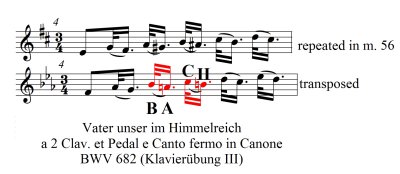
|
|
Canonic variations on the Christmas hymn Vom Himmel hoch, da komm ich her (II), BWV 769, for organ or keyboard instrument with pedal:
Variatio 4, T. 39 (entspricht: Canon per augmentationem)
Variatio 5, T. 56 (Canto fermo in Canone)
[Nürnberg: Balth. Schmid, N. XXVIII (1748). BGA XL; NBA IV/2]
See: Detailed explanation [PDF] (1747) |
|
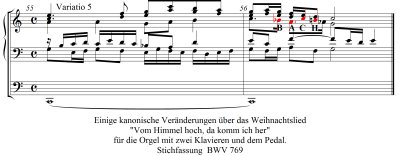
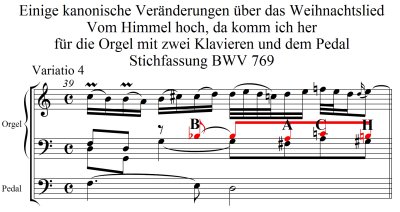
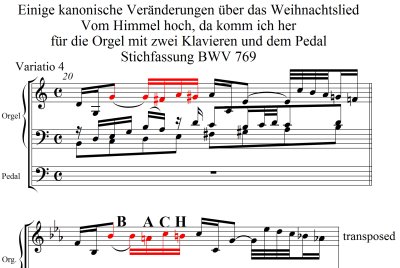
|
|
Sinfonia No. 9 in F minor, BWV 795 [BGA III, XLV; NBA V/3, V/5] (Completed 1723)
The B-A-C-H motif in Bach’s Sinfonia #9 BWV 795 is encapsulated in a prominent three-note motif that is presented in the first measure where it appears in a transposed form (if transposed to another key it would yield the letters B-A-C-H). In this transposed form it can be found at least a dozen times throughout this piece. At approximately the midpoint of this Sinfonia in m. 17, the B-A-C-H motif can actually be seen only once in its true form with the correct musical rendering of the note letters as a ‘signature’.
The first note of the three-note motif is sensed as a pickup to the second note (B in German, Bb in English) which is involuntarily emphasized because it receives the stronger (second) beat just as the fourth beat on C does as well. This helps to relate and combine the first segment (B-A) with the second (C-H) despite the fact that a rest intervenes. The repetition of the note and letter A aids in stretching this note over the rest so that it is not perceived as a distinctly different note but rather a continuation from the first to the second segment.
To enhance the Affekt, Bach combines the passus duriusculus (indicated in blue) with the three-note suspirans figura, a powerful combination. This can be seen clearly in color-coded score. The orange notes indicate all the instances where transposed forms of the B-A-C-H motif can be found. Beginning with m. 28, there is a veritable ‘stretto’-like effect where the occurrences of the motif are piled one on top of the other. Not accounted for here are other places in this composition where the motif remains imperfect (cannot be transposed exactly to produce B-A-C-H but does come close to it).
(Thomas Braatz, July 31, 2011) |
|

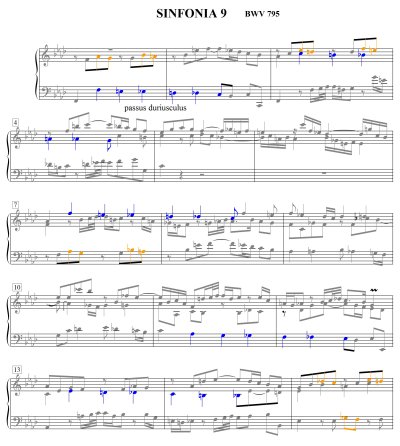
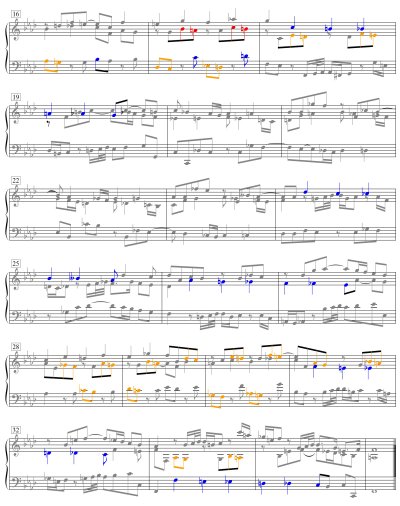
|
|
Complete Score in Capella: Version 1 | Version 2 [Explanation] |
|
English Suite No. 6 in D minor, BWV 811: Gigue [BGA XLV/I; NBA V/7] (1725 or earlier)
Schiff's performances were, as expected, masterly, especially energetic and lively in the fast movements, delicately tripping and poetically introspective in the Sarabandes. If, for Schiff, Bach's style in the French Suite suggested some of the qualities of a painting by Vermeer, transparent and detailed, the D minor English Suite was on a more majestic scale, more like a Rembrandt. In its final movement, Schiff drew an interesting comparison of the
Gigue with Beethoven's Waldstein sonata, in which a trill was combined with leaping arpeggios, while in the Gigue's second part he etched out the B-A-C-H motif stridently.
Source: Bach the European (Music & Vision) |
|
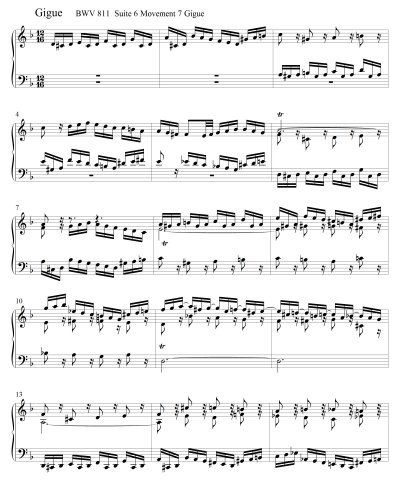

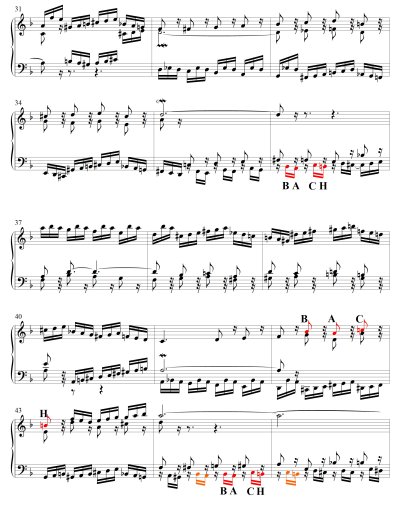

|
|
Prelude in C major, BWV 846a (Before 1720)
In NBA KB V/6.1 on p. 132, Alfred Dürr states that there are indications that there must have been in existence before 1720 two, no longer extant, copies of the original Das Wohltemperierte Klavier I. It is from this early stage of development that a copy of this prelude originates and is designated as BWV 846 α 1. It would appear that taking into account some other examples of Bach’s musical signature such as BWV 651, BWV 667, BWV 769 (var. 5), BWV 1079 (Ricercar a 6), where it can easily move to an adjacent part or voice, there is here a possible B-A-C-H motif ‘signature’ which is much clearer in the BWV 846 α 1 copy than it is in the later 1722 version. However, it is still recognizable in this later version of the Praeludium which has become one of Bach’s most famous compositions.
(Thomas Braatz, July 27, 2011) |
|
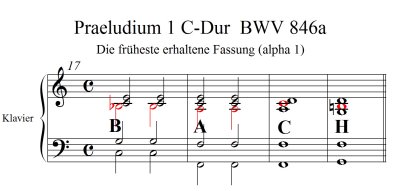

|
|
J.S. Bach [Doubtful]:
Prelude & Fugue in B flat major on the name BACH, BWV 898, for keyboard instrument
(According to the most recent research, BWV 898 is definitely not by J.S. Bach. It could possibly be by Kellner, but this has not been firmly decided as yet).
[Leipzig: Breitkopf & Härtel 1823. BGA XLII, S. XXXIV (Themen); NBA V/12]
See: Summary from NBA KB V/12 [PDF] |
|
Sonata for keyboard in C major, BWV 966 [based on Sonata No. 1 from Hortus musicus by Johann Adam Reincken] (Fuge), for keyboard [Druck: BGA XLII, 42-49] (Before 1705 ?) |
|

|
|
Suite for solo cello No. 5 in C minor, BWV 1011 [BGA XXVII/1; NBA XXVII/1] (c1720)
In his interpretation of the suites, Pergamenschikow believed that part of the cellist's job was to set out on a journey of discovery: what is this music about, really? It had to become a journey into the mind and creative spirit of the composer, and this particular cellist kept thinking, over and over again, about what this part or that in the score might be taken to mean. 'A lot of this is puzzling stuff and allows for varying interpretations. For example, is the BACH motif in the 22nd bar of the Courante from the fifth suite just a sequence of seconds that seems natural to us, or is it the composer marking the work with a hidden signature?' he asked.
Source: Bach Cello 3 (Music & Vision) |
|
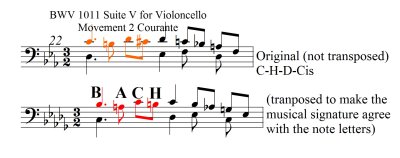
|
|
Brandenburg Concerto No. 2 in F major, BWV 1047, for trumpet, recorder, oboe, violin, 2 violins, viola & continuo: Mvt. 1 [BGA XIX; NBA VII/2] (1721)
It is right there where you might expect it to be at the end of the movement, but this time expanded over the space of 4 measures.
(Thomas Braatz, August 3, 2011) |
|

|
|
Musical Offering BWV 1079: Ricercare à 6 (1747) | Recordings
The presence of the B-A-C-H motif in the final measures of this monumental Ricercar a 6 (2nd section of the printed version of the Musical Offering) points to a deliberate, intentional effort on Bach’s part to include his musical signature at the end of a composition which was of great significance and importance to him. Again, as at the end of the 5th Variatio of the Canonic Variations BWV 769, the segment with the letters B-A is separated from the segment C-H which appears in very close proximity to the former. There are two different musical lines involved here in the BWV 1079 Ricercar a 6 where there are clearly two soprano parts, but in BWV 769 it is more difficult to discern whether the B-A-C-H is sounded by two alto parts or one alto and a second soprano part. Check also BWV 667 where a similar circumstance prevails.
(Thomas Braatz, July 27, 2011) |
|
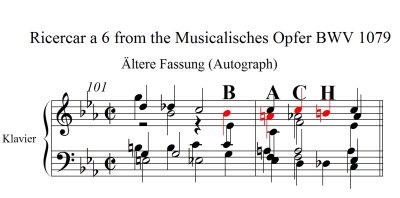
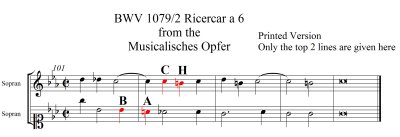
|
|
Die Kunst der Fuge BWV 1080: Contrapunctus XI und XIX [Erstdruck: 1751. BGA XXV/1; NBA VII/2] (c1742-1749) | Recordings |
|
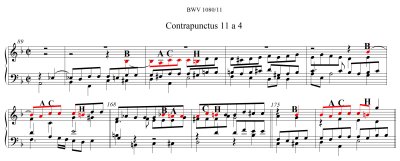
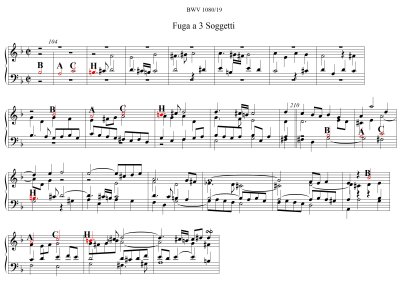
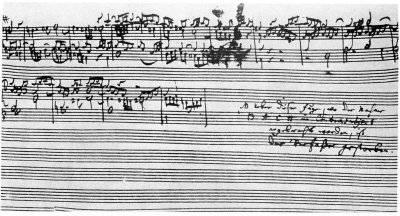 |
|
Chorales: |
|
#166 Es stehn vor Gottes Throne, BWV 309, m13: |
|
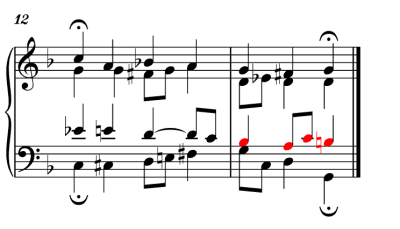
|
|
#174 Jesus Christus, unser Heiland, BWV 364, mm. 10-11: |
|
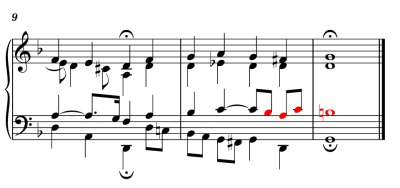
|
|
#190 Herr, nun laß in Friede, BWV 337, mm. 11-12: |
|
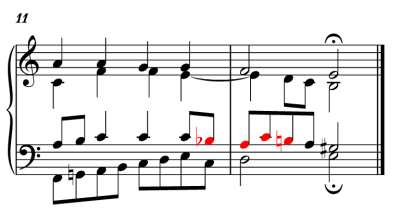
|
|
#203 O Mensch, schau Jesum Christum an, BWV 403, mm. 20-21: |
|

|
|
#218 Laß, o Herr, dein Ohr sich neigen, BWV 372, mm. 15-16: |
|

|
|
#235 Heilig, heilig, BWV 325, mm. 1-2: |
|

|
|
same chorale set to different text: #319 Sanctus, sanctus Dominus Deus Sabaoth, BWV 325, mm. 1-2: |
|
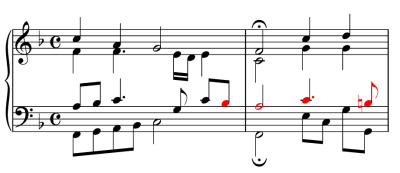
|
|
#268 Nun lob, mein Seel, den Herren, BWV 389, m. 13 (not at end or beginning): |
|
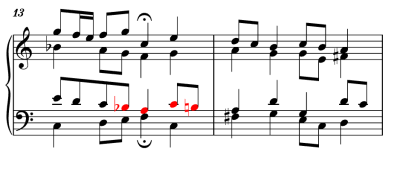
|
|
In the first 5 examples, the BACH motif appears in the last two measures of the chorale, and all in the tenor part.
In the next example, the BACH motif appears in the first two measures of the chorale, and in the tenor part.
In the last one, the BACH motif appears in the middle of the chorale, and in the tenor part. |
|
Source: Discussion Ideas for a simple Bach analysis? in Google Groups "music21" group (May 8-9, 2017).
Participants: Andrew Sanchez & Craig
This discovery was done using Python programming language. |
|
Thomas Braatz added (August 26, 2017): These should definitely be listed as a group under those composed by J.S. Bach himself, particularly the first 5 examples where the motif occurs as part of the final cadence at the end of the chorale. There this motif is located at the end of the chorale as a signature which normally appears in such position at or after the conclusion of a composition. There may even be an association with the text of the chorale. I would need to investigate such a connection to see if it might also be meaningful for J.S. Bach to relate himself personally to chorale's subject matter. Another direction to be researched is whether this motif also occurs as transposed to another key. |
| |
| |
Continue on Part 2 > |
|
Prepared by Aryeh Oron (July 2011 - August 2017)
Thanks to contributors: Thomas Braatz (July-August 2011), Evan Cortens (July 2011), Arthur Ness (July 2011) |
|
|